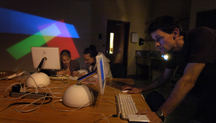
Purdue program fuses collaboration in art, technology
WEST LAFAYETTE, Ind. — Imagine watching a movie on DVD that changes its storyline each time it's played. Consider theater scenery rearranging automatically as the actors move from scene to scene.

|
Fabian Winkler, an assistant professor in art and design, is establishing the electronic and time-based art area in the Patti and Rusty Rueff Department of Visual and Performing Arts.
"People can probably relate relatively easy to this emerging area of art because of the media culture around them, including video games, smart devices and home computers," Winkler says. "However, the first thing students learn is to abandon the passive role of the media consumer and become a creator."
Instead, merging art and science offers opportunities for new forms of creative expression beyond our imagination, Winkler says. The resulting artworks often question everyday assumptions and take unexpected, sometimes humorous turns — printers start to read out loud while printing, movie storylines reorganize themselves every time we watch a DVD, power lines respond to the electrical charges in people approaching them, theater stage backdrops respond in real time to actors, or sculptures interact with an audience by following different cues.
"The heart of this program is rooted in visual and performing arts with the aim to bridge disciplines such as art, design, dance, music and theater with the creative use of digital technologies," he says. "I also see a tremendous potential for collaboration with electrical and computer engineering, computer science and computer graphic technology, as well as other academic disciplines at Purdue."
In the spring, Winkler is teaching "Envision Art 01: The Responsive Screen." The visual arts course number is A&D590E for registration purposes. This class will meet at Purdue's Envision Center for Data Perceptualization, a facility allowing three-dimensional visualization of data. The class is designed to learn how digital images, such as computer graphics, can interact with physical objects, such as people, furniture or machines. Other physical objects may use sensors and actuators to stimulate the graphic images.
Electronic and time-based art is a young academic field that has only been around for about 10 years, Winkler says. Carnegie Mellon University in Pittsburgh, where Winkler recently taught, is one of the other few centers that offer this type of program as are University of California at Los Angeles and Rhode Island School of Design.
"What makes this form of art even more interesting is that there is often a public component to my work," Winkler says. "The artists are always engaging with the community."
One of Winkler's projects, called Waves, utilizes public wading pools in Toronto, Canada. Winkler teamed with Shannon McMullen, who is his wife and a visiting scholar in Purdue's art and design division, to create buoys that measure the movement of waves. Then they translate that motion into a musical sound.
"Most people think of buoys as purely functional, they provide navigation information, form barriers and serve as traffic guides," Winkler says. "Our project Waves allows people to see the buoys as art. Each buoy plays an electronically generated tone that is modulated by water waves and thus reflects the persons' movements in the wading pool.
"The sound is not only enjoyable, but it encourages social interaction in otherwise rather anonymous urban spaces."
Winkler is teaching "Interactive Light" this fall, and the students in the class are searching for a vacant community space to create a light exhibit for the public to visit in November. He also will teach "Audio-Visual Sculpture" in the spring. The course number for the spring class is A&D490E.
The Patti and Rusty Rueff Department of Visual and Performing Arts is housed in the College of Liberal Arts.
Writer: Amy Patterson Neubert, (765) 494-9723, apatterson@purdue.edu
Source: Fabian Winkler, (765) 494-0160, fwinkler@purdue.edu
Purdue News Service: (765) 494-2096; purduenews@purdue.edu
PHOTO CAPTION:Fabian Winkler, an assistant professor of visual and performing arts, demonstrates a project from his "Interactive Light" class, while students, from left, Andrea Dailey of Fort Wayne, Ind., and Jasmine Grskovic of Michigan City, Ind., work on circuitry. The two first-year graduate students in photography are preparing projects for a November light art exhibition. Winkler is establishing a new program, the electronic and time-based art area, in Purdue's Patti and Rusty Rueff Department of Visual and Performing Arts. (Purdue News Service photo/David Umberger)
A publication-quality photo is available at https://www.purdue.edu/uns/images/+2006/interactive-light.jpg
To the News Service home page